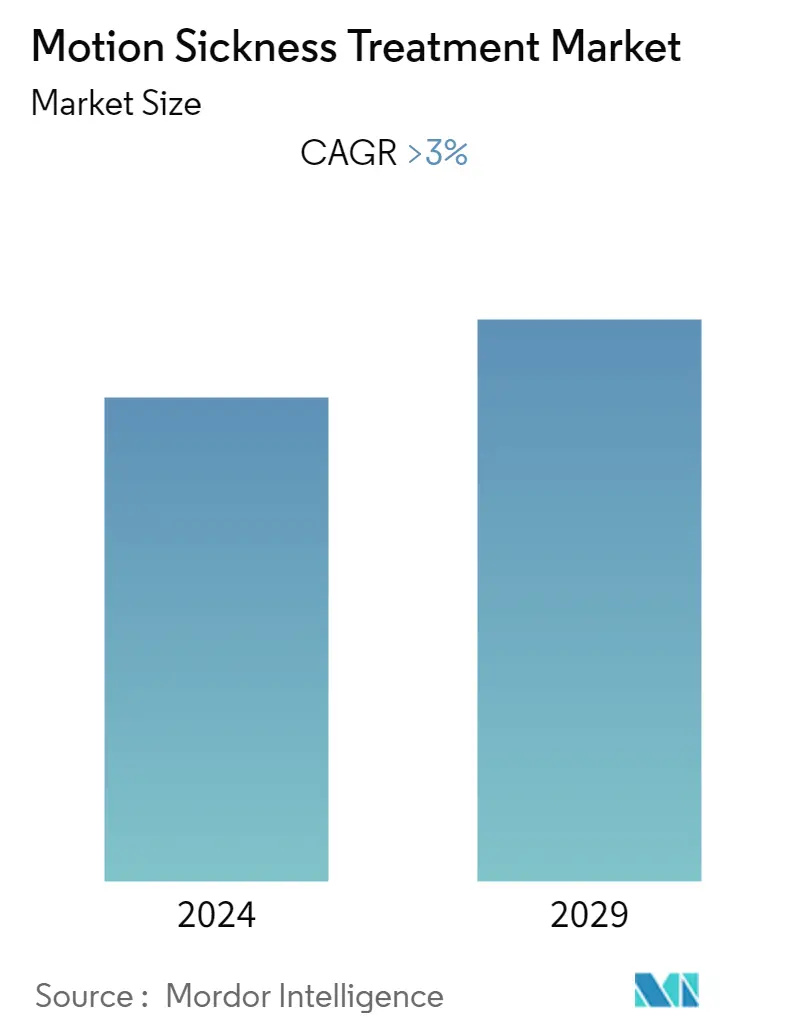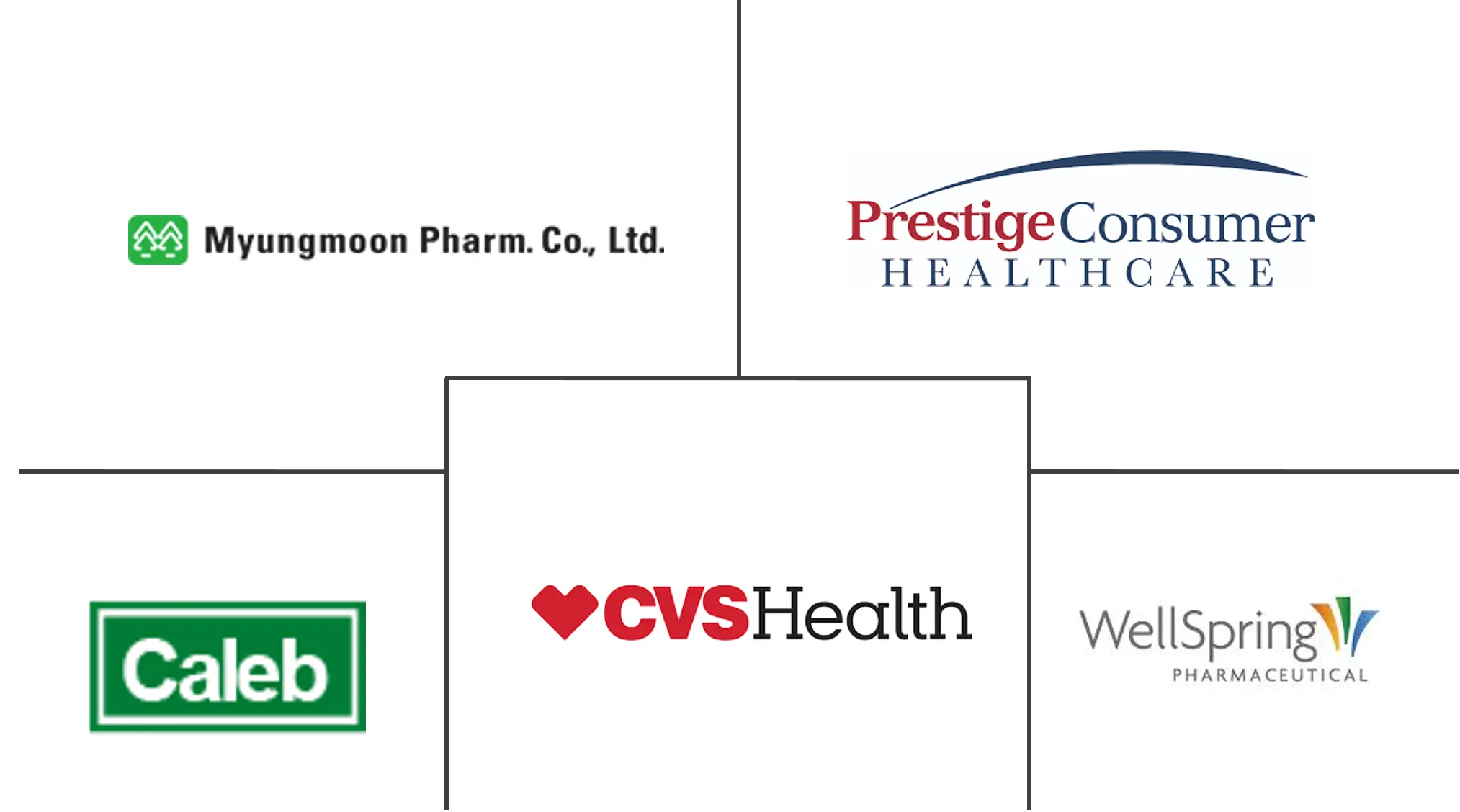Market Size of Motion Sickness Treatment Industry

| Study Period | 2021 - 2029 |
| Base Year For Estimation | 2023 |
| CAGR | 3.00 % |
| Fastest Growing Market | Asia-Pacific |
| Largest Market | North America |
| Market Concentration | Medium |
Major Players
*Disclaimer: Major Players sorted in no particular order |
Motion Sickness Treatment Market Analysis
During the forecast period, the market for medicines to treat motion sickness is expected to register a CAGR of 3.0%.
The COVID-19 pandemic affected healthcare systems globally and resulted in the interruption of usual care in many healthcare facilities, exposing vulnerable patients with cancer to significant risks. According to a CDC article, the number of international tourist arrivals worldwide fell by 73% in 2020 compared to the previous year due to the impact of the coronavirus (COVID-19) pandemic.The global volume of international visitor arrivals reached 415 million in 2021, up 4% from 2020 but still far below pre-pandemic levels. Thus, the low tourist arrivals due to the complete lockdown have impacted the growth of the studied market. However, as restrictions are lifted and tourism resumes in countries, the market is expanding, and international arrivals are expected to return to pre-pandemic levels in two to three years.
Factors such as an increase in the number of travelers and virtual reality exposure around the world, as well as an increase in the use of prescription motion sickness drugs, are driving market growth.
The rise in the number of travelers across the globe is increasing motion sickness, which further boosts the demand for motion sickness treatment. For instance, according to the data published by the UNWTO, in November 2022, an estimated 700 million tourists traveled internationally between January and September of that year, an increase of more than twice the number of tourists who traveled for the same period in 2021. In addition, as per the same source, more than 477 million tourists traveled in Europe in January-September 2022, reaching pre-pandemic levels by 81%. Thus, the increasing number of people traveling across countries increases the risk of experiencing motion sickness, which in turn is expected to increase the demand for effective drugs that reduce the symptoms, hence propelling the market's growth.
Additionally, as per an article published in Frontiers in Bioengineering and Biotechnology in April 2021, it has been observed that females experience more symptoms of motion sickness than males in virtual reality (VR). Thus, the high burden of motion sickness, especially in females, is expected to increase the demand for antihistamines and anticholinergic drugs that block the emetic H1-receptors to prevent motion sickness. This is anticipated to augment market growth over the forecast period.
Furthermore, the rising company's focus on launching products that treat and reduce motion sickness symptoms is also contributing to market growth. For instance, in August 2021, Reliefband launched Reliefband Sport, a new IPX7-designated waterproof wearable therapeutic device that offers user-controlled therapy to prevent and treat nausea and vomiting associated with motion sickness, morning sickness from pregnancy, anxiety, hangovers, physician-diagnosed migraines, chemotherapy, and as an adjunct to antiemetics in treating post-operative nausea.
Therefore, owing to the aforementioned factors, the studied market is expected to grow over the forecast period. However, the reluctance in emerging countries due to the higher cost of prescription drugs and excessive reliance on OTC and traditional medicines is likely to hinder the growth of the market over the forecast period.
Motion Sickness Treatment Industry Segmentation
As per the scope of the report, motion sickness is a common disorder characterized by a set of symptoms such as dizziness, nausea, and fatigue experienced by a person while traveling due to differences in impulses in the eyes, other body tissues, and sensory receptors. The motion sickness treatment market is segmented by treatment type (anticholinergics, antihistamines, and others), distribution channel (retail pharmacies, online pharmacies, and others), and geography (North America, Europe, Asia-Pacific, the Middle East and Africa, and South America). The market report also covers the estimated market sizes and trends for 17 countries across major regions globally. The report offers the value (in USD million) for the above segments.
| By Treatment Type | |
| Anticholinergics | |
| Antihistamines | |
| Other Treatment Types |
| By Distribution Channel | |
| Retail Pharmacies | |
| Online Pharmacies | |
| Other Distribution Channels |
| Geography | ||||||||
| ||||||||
| ||||||||
| ||||||||
| ||||||||
|
Motion Sickness Treatment Market Size Summary
The motion sickness treatment market is poised for growth, driven by an increase in global travel and exposure to virtual reality, which heightens the incidence of motion sickness. The market is recovering from the disruptions caused by the COVID-19 pandemic, with tourism resuming and international arrivals expected to return to pre-pandemic levels. This resurgence in travel is anticipated to boost the demand for motion sickness treatments. The market is characterized by a growing use of prescription medications, particularly antihistamines and anticholinergic drugs, which are effective in alleviating motion sickness symptoms. The introduction of innovative products, such as wearable devices that offer user-controlled therapy, further supports market expansion. However, challenges such as the high cost of prescription drugs in emerging markets and a reliance on over-the-counter and traditional remedies may impede growth.
North America is expected to experience significant market growth, fueled by increased tourism and the adoption of prescription drugs like scopolamine, known for its efficacy in reducing motion sickness symptoms. The region's market growth is also supported by ongoing clinical studies and product launches aimed at enhancing treatment options. The competitive landscape of the motion sickness treatment market is marked by the presence of major players engaging in strategic activities such as mergers, acquisitions, and partnerships to strengthen their market position. These companies are actively involved in developing and launching new products to meet the rising demand for effective motion sickness treatments, thereby driving the market forward.
Motion Sickness Treatment Market Size - Table of Contents
-
1. MARKET DYNAMICS
-
1.1 Market Overview
-
1.2 Market Drivers
-
1.2.1 Increased Number of Travellers and Virtual Reality Exposure Across the Globe
-
1.2.2 Rise in Adoption of Prescription Motion Sickness Drugs
-
-
1.3 Market Restraints
-
1.3.1 Reluctance in Emerging Countries due to Higher Cost of Prescription Drugs
-
1.3.2 Excessive Reliance on the OTC and Traditional Medicines
-
-
1.4 Porter's Five Forces Analysis
-
1.4.1 Threat of New Entrants
-
1.4.2 Bargaining Power of Buyers/Consumers
-
1.4.3 Bargaining Power of Suppliers
-
1.4.4 Threat of Substitute Products
-
1.4.5 Intensity of Competitive Rivalry
-
-
-
2. MARKET SEGMENTATION (Market Size by Value - USD million)
-
2.1 By Treatment Type
-
2.1.1 Anticholinergics
-
2.1.2 Antihistamines
-
2.1.3 Other Treatment Types
-
-
2.2 By Distribution Channel
-
2.2.1 Retail Pharmacies
-
2.2.2 Online Pharmacies
-
2.2.3 Other Distribution Channels
-
-
2.3 Geography
-
2.3.1 North America
-
2.3.1.1 United States
-
2.3.1.2 Canada
-
2.3.1.3 Mexico
-
-
2.3.2 Europe
-
2.3.2.1 Germany
-
2.3.2.2 United Kingdom
-
2.3.2.3 France
-
2.3.2.4 Italy
-
2.3.2.5 Spain
-
2.3.2.6 Rest of Europe
-
-
2.3.3 Asia-Pacific
-
2.3.3.1 China
-
2.3.3.2 Japan
-
2.3.3.3 India
-
2.3.3.4 Australia
-
2.3.3.5 South Korea
-
2.3.3.6 Rest of Asia-Pacific
-
-
2.3.4 Middle East and Africa
-
2.3.4.1 GCC
-
2.3.4.2 South Africa
-
2.3.4.3 Rest of Middle East and Africa
-
-
2.3.5 South America
-
2.3.5.1 Brazil
-
2.3.5.2 Argentina
-
2.3.5.3 Rest of South America
-
-
-
Motion Sickness Treatment Market Size FAQs
What is the current Motion Sickness Treatment Market size?
The Motion Sickness Treatment Market is projected to register a CAGR of greater than 3% during the forecast period (2024-2029)
Who are the key players in Motion Sickness Treatment Market?
Prestige Consumer Healthcare Inc, WellSpring Pharmaceutical Corporation, Caleb Pharmaceuticals Inc, Myungmoon Pharm Co Ltd and CVS Health are the major companies operating in the Motion Sickness Treatment Market.

